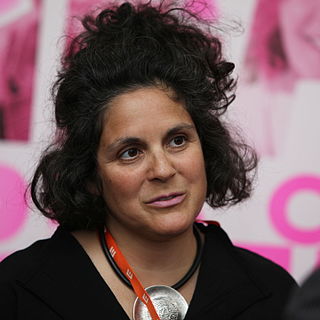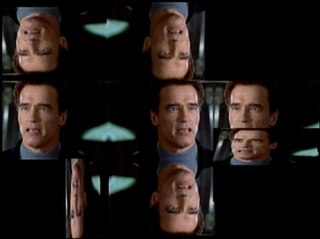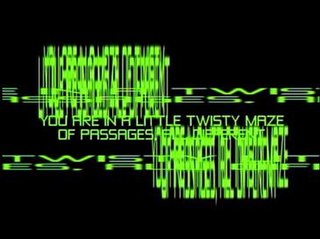
David Paul Cronenberg is a Canadian film director, screenwriter, and actor. He is one of the principal originators of what is commonly known as the body horror genre, with his films exploring visceral bodily transformation, infection, technology, and the intertwining of the psychological with the physical. Cronenberg is best known for exploring these themes through sci-fi horror films such as Shivers (1975), Scanners (1981), Videodrome (1983), and The Fly (1986), though he has also worked in multiple genres throughout his career.

Guy Maddin is a Canadian screenwriter, director, author, cinematographer, and film editor of both features and short films, as well as an installation artist, from Winnipeg, Manitoba. Since completing his first film in 1985, Maddin has become one of Canada's most well-known and celebrated filmmakers.

Fair Warning is the fourth studio album by American rock band Van Halen. Released on April 29, 1981, it sold more than two million copies, but was still the band's slowest-selling album of the David Lee Roth era. Despite the album's commercially disappointing sales, Fair Warning was met with mostly positive reviews from critics.
Attila Richard Lukács is a Canadian artist.

Alpha Dog is a 2006 American crime drama film written and directed by Nick Cassavetes based on the true story of the kidnapping and murder of Nicholas Markowitz in 2000. The cast includes Emile Hirsch, Justin Timberlake, Ben Foster, Shawn Hatosy, Anton Yelchin, Christopher Marquette, Olivia Wilde, and Amanda Seyfried with Harry Dean Stanton, Sharon Stone, and Bruce Willis. Alpha Dog was first screened at the Sundance Film Festival on January 27, 2006, and had a wide release the following year on January 12. It grossed $32 million worldwide on a budget of $9 million.

The Maze is a painting that Canadian artist William Kurelek produced while a patient at Maudsley Hospital in London. Kurelek was born in 1927 into a Ukrainian immigrant community in Alberta, Canada, and suffered through childhood from the oppression of his farmer father. As a young adult he grew mentally ill, and at Maudsley received not only treatment but a room to paint. The Maze can be interpreted as Kurelek's attempt to justify this privilege; as Kurelek writes, "I had to impress the hospital staff as being a worthwhile specimen to keep on."

Nicodemo Antonio Massimo Mancuso is an Italian-Canadian actor, artist, playwright, and director. Beginning his career as a stage actor, he had his breakthrough role in the 1981 drama Ticket to Heaven, for which he won the Genie Award for Best Performance by a Leading Actor. He has over 155 film and television credits, including a starring role on the NBC series Stingray (1985–87) and as antichrist Franco Macalousso in the Apocalypse film series.

William Kurelek, was a Canadian artist and writer. His work was influenced by his childhood on the prairies, his Ukrainian-Canadian roots, his struggles with mental illness, and his conversion to Roman Catholicism.

John Hamilton Bush was a Canadian abstract painter. A member of Painters Eleven, his paintings are associated with the Color Field movement and Post-painterly Abstraction. Inspired by Henri Matisse and American abstract expressionist painters like Helen Frankenthaler and Morris Louis, Bush encapsulated joyful yet emotional feelings in his vibrant paintings, comparing them to jazz music.

Joan Arden Charlat Murray, is a Canadian writer, curator, art historian and champion of Canadian art history.

Edward Adamson was a British artist, "the father of Art Therapy in Britain", and the creator of the Adamson Collection.
George Barber is a British video artist. His works have been shown at international festivals, competitions, galleries, been broadcast on television throughout the world and awarded prizes.

Jennifer Baichwal is a Canadian documentary filmmaker, writer and producer.
Jaret Vadera is a Canadian artist working between New York, Toronto, and India. Vadera works across media, primarily in the spaces where painting, photography, video installation, and new media intersect.

Daniel Ernest Cockburn is a Canadian performance artist, film director and video artist. Cockburn who won the Jay Scott Prize in 2010 and the European Media Art Festival's principal award in 2011 for his debut feature film You Are Here.

Metronome is a 2002 Canadian short experimental film which mixes appropriated film clips and video by video artist Daniel Cockburn to express ideas about rhythm and order, the self and other minds, and the digital age. Densely philosophical, the work is acknowledged as his international "breakout hit" after several locally successful short works, winning praise from critics, a mention, and an award.

WEAKEND is a 2003 Canadian short experimental film created by video artist Daniel Cockburn, made through a remix of audio and video from The 6th Day, a Hollywood feature film about cloning starring Arnold Schwarzenegger. Commissioned by famefame for the third biennial Tranz Tech Media Art Festival, the work was awarded the Jury prize.
The Impostor is a 2003 Canadian short experimental film by video artist Daniel Cockburn, one of several works commissioned for The Colin Campbell Sessions and inspired by the makings of video art pioneer Colin Campbell for the Tranz Tech festival. Cockburn's video draws formally on Campbell's style while at the same time metaphorically expresses the artist's anxiety in making the video itself.

You Are In a Maze of Twisty Little Passages, All Different: Films and Videos by Daniel Cockburn is a 2009 Canadian experimental film anthology consisting of a curated programme of eleven short films by video artist Daniel Cockburn.
Peter Knegt is a Canadian writer, producer, and filmmaker. He is the recipient of four Canadian Screen Awards and his CBC Arts column Queeries received the 2019 Digital Publishing Award for best digital column in Canada.















